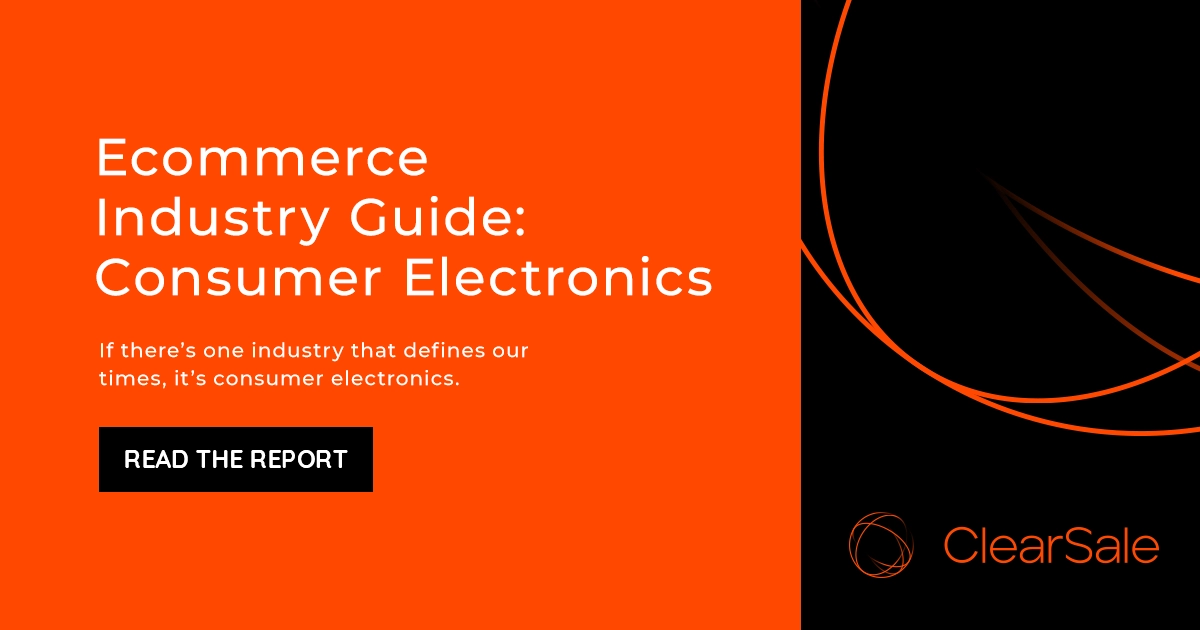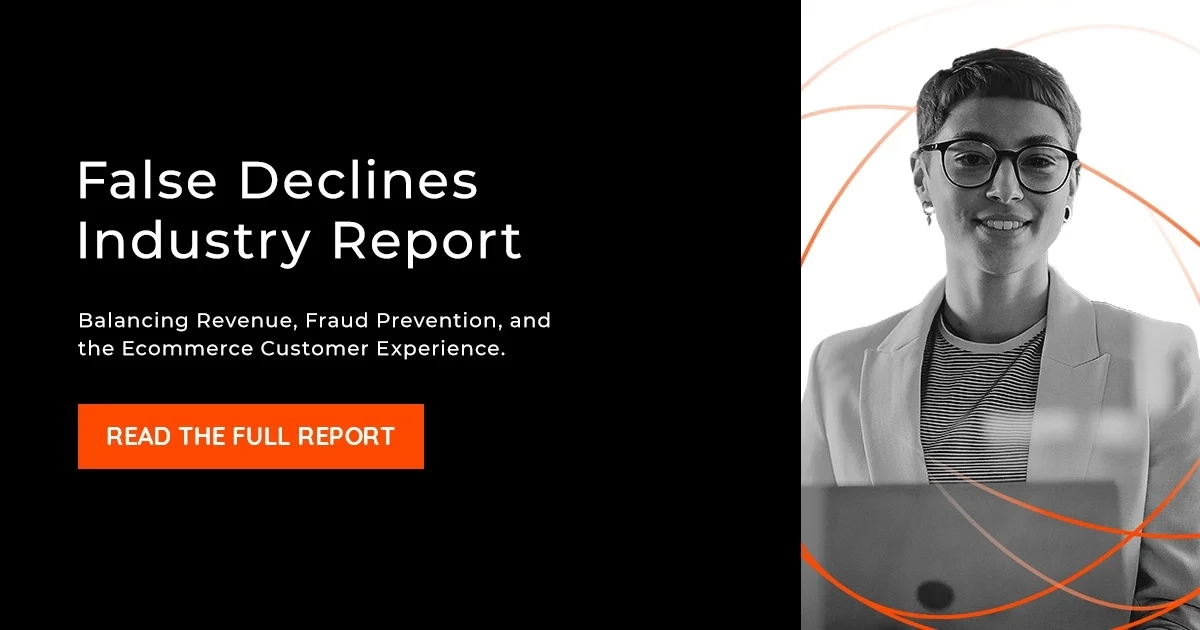Country Profile: The Guide to Ecommerce in Russia
With the fifth-largest economy in Europe, Russia is one of the fastest-growing online shopping markets in the world. Merchants interested in Russian ecommerce have plenty of opportunity to succeed with a young user population and mobile commerce popularity.
In this comprehensive guide, we’ll explore ecommerce in Russia, focusing on what makes this burgeoning market, its distinct consumers and cross-border commerce unique. We’ll explore the opportunities and challenges involved with doing business in Russia. And finally, we’ll offer some tips for preventing fraud while selling into Russia.
Let’s get started!

Russian Market Overview
Russia is a big country. With 11 time zones and approximately 9,000 kilometers between its eastern and western borders, it is nearly double the size of the U.S.
Russian Population Stats
The current population of Russia is about 146 million, making it the ninth-most populated country in the world and the most populated country in Europe. The primary language is Russian, with only 11% of the population speaking English and even fewer who speak German, French or Turkish.
The most populated city in Russia is Moscow with 24% of the population. Almost 70% of Russians live in the western regions, and 4% live in the Far East of Russia.
Russia is a relatively young country -- the median age is 40. Women account for 53% of the population compared to 47% men, and the majority of Russians are in the millennial and Gen Z generations.
Russian Economic Data
Despite its size, Russia comes in fifth among European economies. It has the 11th largest gross domestic product globally at US$1638 billion in 2019 and a projected US$1,940 billion by 2024.
The World Bank ranks Russia 28th in the world for ease of doing business. That puts it two spots ahead of Spain, three spots ahead of China, and five spots behind Canada.
Internet Penetration in Russia
Russians love the being connected to the internet – there are 102,258,256 internet users in Russia and internet penetration is at 71%. Specifically, smartphone penetration accounts for 55% of the population – not surprising given the younger demographic in Russia.

Ecommerce Growth in Russia
Russia has become a hotbed for ecommerce growth – about 81% of the population buy online at least once a month to the tune of US$21.6 billion in retail market value. By 2024, that number is expected to reach US$28.2 billion, with even more growth beyond.
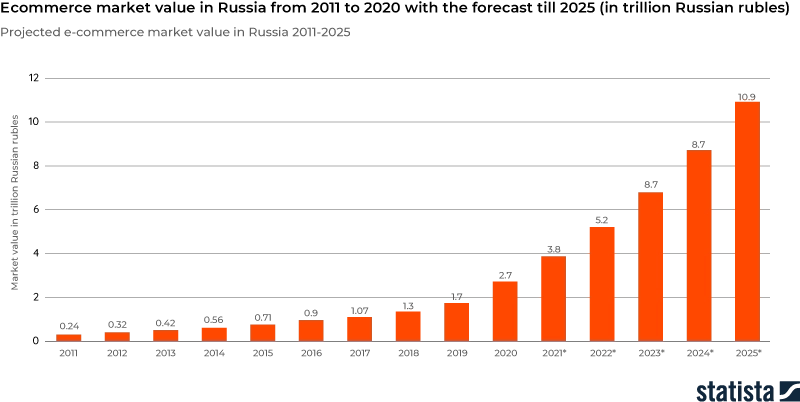
As is the case with nearly every global market, Russian ecommerce surged due to the COVID-19 pandemic. In particular, e-grocery sales were up 250% from 2019. Other industry winners are:
- Electronics and electrical appliances
- Apparel
- Household and furniture
- Beauty and health

Russian Ecommerce Is Fragmented
The Russian ecommerce market is very fragmented. Wildberries currently has about 15% of the market and Ozon has about 7%. Other players include AliExpress Russia, M.Video, Sbermarket, and Yandex.
Amazon has its eyes set on Russia but has yet to enter the market.
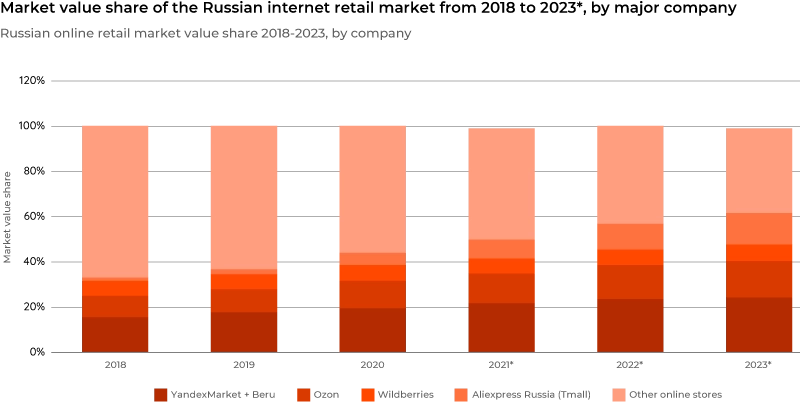

How to Appeal to the Russian Ecommerce Consumer
Ecommerce merchants who plan to sell online in Russia need to understand Russian consumers’ interests, motivators and habits.
They tend to enjoy media, gaming and sports. They’re also loyal to the brands they choose, so merchants need to be aware of the opportunity to attract long-term customers in Russia.
Russians Rely on Mobile Commerce
Russian consumers use smartphones more than desktops or tablets when making online purchases. For enterprise merchants with smartphone apps, this is good news: Russian consumers who shop using mobile apps tend to spend and buy more. In fact, mobile commerce sales in Russia is projected to reach US$19.47 billion by 2023.
Big Opportunity for Social Commerce
About 100 million Russians are on a social media every day, with the most popular platform being VKontakte (also known as VK), the country’s equivalent to Facebook. VKontakte has nearly 67 million users in Russia – mostly millennials – who sign on at least monthly. Facebook is a close second with 66 million active monthly users, followed by Instagram with 57 million active monthly users. On average, Russians are on social media about 2.33 hours each day.
|
|
What online merchants will find interesting – and good news – is that Russian social media users welcome advertisements. Personalized advertising in Russia is quite influential and consumers enjoy the convenience of receiving personal product suggestions. |
Personalization is Key
Personalization is quickly becoming a standard need in ecommerce and Russian ecommerce is no exception. By personalizing the customer experience, online merchants help customers find what they need quickly and efficiently. Merchants average 10% higher conversion rates through personalization such as displaying products similar to previous purchases, personalized shopping carts, and special offers that are customer-specific.
Russian Consumers Value a Good Deal
Pricing and the opportunity to purchase products at a lower cost is a huge factor for Russian ecommerce – domestically and internationally. In fact, about 53% of Russian shoppers say they will price shop to find the deals. (Only 6% don’t pay attention to discounts while shopping.) Cross-border commerce merchants selling into Russia need to highlight quality and value, as well as any discounts and special offers.
|
|
Cross-border commerce merchants selling into Russia need to highlight quality and value, as well as any discounts and special offers. |

Common Russian Ecommerce Challenges
The challenges associated with Russian ecommerce mostly involves logistics, which cross-border ecommerce into Russia involves a number of additional challenges. Let’s take a look at the most significant factors to consider.
Logistics Has Been an Issue
Even prior to the pandemic, logistics were no piece of cake in Russia. It's a large territory with remote settlements — which can often only be reached by roads best described as "dicey." The only logistics operator delivering throughout Russia? The Russian Post.
When the pandemic hit, logistics became an even bigger issue for Russian ecommerce merchants, as demand strained shipping capabilities. It’s one thing to have consumers shopping in stores and then having it shipped to their homes – even across thousands of miles. It’s an entirely other situation when the only way any consumers can shop is online and they have to wait for their products to be shipped across thousands of miles. It pretty much eliminates the option of next-day shipping.
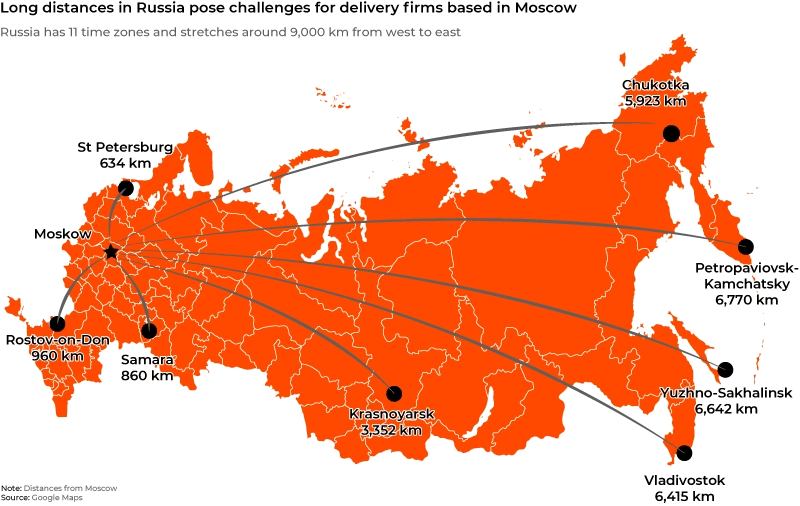
And that was a problem the big three merchants had to solve. Russian consumers are big fans of BOPIS (buy online, pick up in-store) and Pick up Drop off – where products are shipped to a locker for consumers to pick up at their convenience.
That forced some creative solutions, such as adding more delivery pick-up points. Delivery is carried out via specialized networks such as Pickpoint, Russian Post offices and specialized grocery stores such as Pyaterochka. The number of pick-up points grows constantly: These increased 47% between May 2019 and September 2020 – there are now 39,000 locations throughout Russia. Ecommerce organizations need to create relations and contracts with these pick-up locations.
So, while the issue of logistics has a workaround, it is still a consideration for online merchants. Despite the need for coordination and long-distance shipping – the distance between Moscow and the eastern-most cities is over 6,000 miles – Russian consumers are accustomed to free, cheap and next-day delivery. Merchants will need to have a very clear and fully orchestrated shipping and delivery process to compete in the Russian ecommerce market.
|
|
Merchants will need to have a very clear and fully orchestrated shipping and delivery process to compete in the Russian ecommerce market. |
Russians Have Very Specific Payment Preferences
Ecommerce merchants selling into Russia need to offer a full range of payment options, including digital wallets, credit cards, buy now pay later and other alternative payment methods, as well as a few options specific to the country’s consumers.
Cash on Delivery
Credit cards have become more widespread throughout the region, and most Russians now have bank accounts as well. However, cash on delivery (or cash at pickup) is still the most popular way to pay for orders. For some online merchants, this may not be possible, but it is a consideration, depending on the demographic and region.
MIR
Launched by the Central Bank of Russia in 2014 to reduce Russia’s dependence on international payment systems, the MIR card accounts for 15% of online purchases in Russia. State employees and military staff are required to use it. While it is still not available in foreign markets, that may change in the future.
Russian Consumer Data Must Be Hosted in Russia
Cross-border commerce merchants need to be aware of the privacy and data security protections they’ll need to accommodate.
Within Russian data protection legislation, there is a “localization requirement” that says any collection, recording, storage and extraction of personal data of Russian citizens has to be initially executed using databases on servers in Russia.
That means an online merchant outside of Russia will need a hosting services provider with servers in Russia that will house all data files pertaining to its Russian consumers.
Limited English Language Proficiency
Another consideration is language. Russia has one of the lowest English language proficiency levels in Europe. However, shopping from foreign online stores has seen a significant growth in Russia when these ecommerce organizations adapted their websites to the Russian market by translating their website into Russian.
Ecommerce teams should ensure not only websites, but texts, emails, and any other communication along the buying journey are accurately (ideally natively) translated into Russian.
Certain Goods Cannot Be Sold into Russia
Another factor to consider – the types of products that cannot be sold into Russia from other countries. These include:
- Alcohol
- Prescription drugs
- Tobacco products
- Narcotic or psychotropic substances and poisons
- Occult goods
- Weapons
Jewelry and other products made of precious metals or stones can be sold, but they are subject to special regulation.
Before launching an online business that sells in Russia, merchants need to know these potential limitations.
They also need to have a strategy for preventing fraud.

Ecommerce Fraud in Russia
As is the case in almost every other country, the exponential growth in ecommerce in Russia has also opened the floodgates to more fraud.
Ecommerce fraud in Russia typically involves account takeover (ATO) fraud due to increasing digital wallet usage, card-not-present (CNP) fraud, bot attacks, mass registration and loyalty abuse.
Account Takeover (ATO) Fraud
Account takeover fraud happens when fraudsters acquire hacked users’ accounts, where they withdraw money, make purchases, and use merchant credits to get free goods and services.
Card-Not-Present (CNP) Fraud
Card-Not-Present fraud is similar to account takeover. However, the fraudster usually purchases credit card credentials illegally and uses those credentials to make purchases.
When CNP fraud happens, merchants are typically responsible for chargebacks.
When a cardholder notices an unauthorized payment on their account, a chargeback is initiated. The cardholder will notify their card-issuing bank. If the bank determines the claim is legitimate, the bank will refund the payment and debit the merchant – usually with an additional fee ranging from $50 to $100 or more per transaction.
Chargebacks aren’t the only way online fraud can harm a merchant’s ecommerce business. Fraud can impact their relationship with customers, and it can also cost the value of shipped and unpaid merchandise.

How to Prevent Fraud When Selling Into Russia
To prevent fraud-related damages, ecommerce merchants selling into Russia have four basic fraud protection options:
1. Fraud Filters
Fraud filters are provided by ecommerce platforms and are designed to identify potentially fraudulent orders and stop them from being processed.
Fraud filters can function in a number of ways, such as by:
- Limiting how many sales can be submitted to a website during a given time period.
- Using an address verification service (AVS) to ensure shipping and billing addresses match.
- Flagging or blocking transactions that occur during specified timeframes.
- Checking for errors with the card verification value (CVV) submitted.
- Flagging high-dollar sales that fall outside the merchant’s typical range.
- Looking for IP address mismatches.
The Risk of False Declines
While these common filters can prevent a high amount of fraud, they may also prevent many legitimate transactions from going through.
When a fraud prevention measure denies a legitimate transaction, it is called a false decline.
If ecommerce customers the world over have anything in common, it’s their distaste for false declines. No one – from the UK to the U.S. to Australia to Mexico – likes being told their payment method is suspicious. False declines drive away customers (often never to return) costing ecommerce businesses up to 13 times as much as fraud.
|
|
False declines drive away customers (often never to return) costing ecommerce businesses up to 13 times as much as fraud. |
2. Manual Review
An alternative to automatic fraud filters is manual fraud review, which is just what it sounds like: a team of individuals reviewing each transaction (or a selection of transactions) to detect fraud.
Human fraud experts tend to be better than machines at understanding context. Trained fraud experts can look at each situation individually instead of blindly adhering to preset rules.
However, manual review is very time-consuming and resource-intensive. A drawn-out manual review process can annoy customers who are eager to complete their orders.
3. Machine Learning/Artificial Intelligence
Software that relies on machine learning or artificial intelligence (AI) can provide a fast and reliable way to screen out fraud. These applications rely on mathematical algorithms and data to identify fraud trends and patterns. Because no humans are involved, machine learning is scalable and consistent, applying the same level of scrutiny to every transaction.
Unfortunately, like “unintelligent” fraud filters, machine learning can be inflexible. Algorithms can also miss new types of fraud that haven’t yet made it into the algorithm’s database.
4. Fraud Managed Services
Fraud managed services is a “best of all worlds” approach that combines cutting-edge automated technology (including advanced fraud filters and machine learning) with expert manual analysis.
At no point is an order automatically declined. Instead, when the automated system flags an order, the order is passed on to the team of experts who use their knowledge of human behavior and the latest fraud trends to make a final call. Human analysts can flag new trends for insertion into the AI’s algorithm, thereby helping the machine learn faster.
Russian Consumer Rights and Fraud Protection
Unlike many other countries, Russia protects the rights of consumers when they make purchases online or in person. The policies involved can make it difficult for merchants to distinguish attempted fraud from legitimate consumer issues.
Specifically, consumers are entitled to any of the following:
- Reduced purchase price
- Replacement of goods
- Refund of amount paid
Special rules also apply to online transactions in Russia, including:
- Consumers can reject their purchase at any time before products are delivered and within seven days after delivery.
Consumers can reject their purchase within three months after delivery if the products don’t live up to their description.
Online merchants selling into Russia need a comprehensive understanding of fraud and the regulations that can impact fraud to implement the most effective solution.

The Most Effective Fraud Solution for Russian Ecommerce: ClearSale
As an expansive country with younger consumers who embrace technology, Russia offers tremendous opportunities for online merchants everywhere.
But to be successful in the Russian market, merchants need a fraud prevention solution that stays one step ahead of the most sophisticated fraudsters while eliminating false declines and giving customers a seamless shopping experience.
ClearSale does just that.
At ClearSale, our fraud managed services solution combines advanced statistical and artificial intelligence technology with the world’s largest team of specialized fraud analysts to deliver a balanced, real-world approach that is unlike anything else in the Russian ecommerce market.
With ClearSale, ecommerce merchants receive:
- Simple ecommerce integration. Our fraud protection solutions quickly integrate with all major ecommerce platforms via an easy-to-install plugin.
- Near-immediate order approvals. Even our human analysts are typically lightning-fast.
- Comprehensive protection against fraud. ClearSale’s Chargeback Insurance program offers 100% guaranteed coverage of all fraud-related chargebacks.
- The highest approval rates in Russia (and anywhere else). Our system will never auto-decline an order.
- An innovative approach. Our multitiered team approach to fraud prevention lets us continually calibrate our proprietary statistical model as new fraud patterns emerge.
With clients in Europe, North America, Latin America—and everywhere else online shopping thrives— ClearSale knows global ecommerce.
If you’re thinking about expanding the reach of your ecommerce business into Russia, get in touch with us today to talk about keeping your business, your reputation, and your customers safe from fraud.
 David Fletcher
David Fletcher
